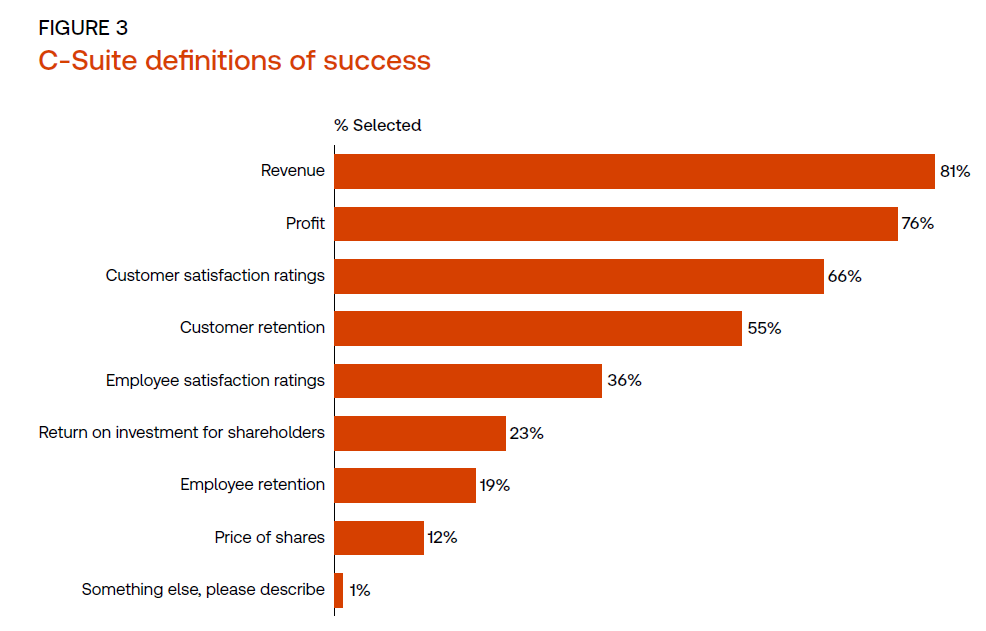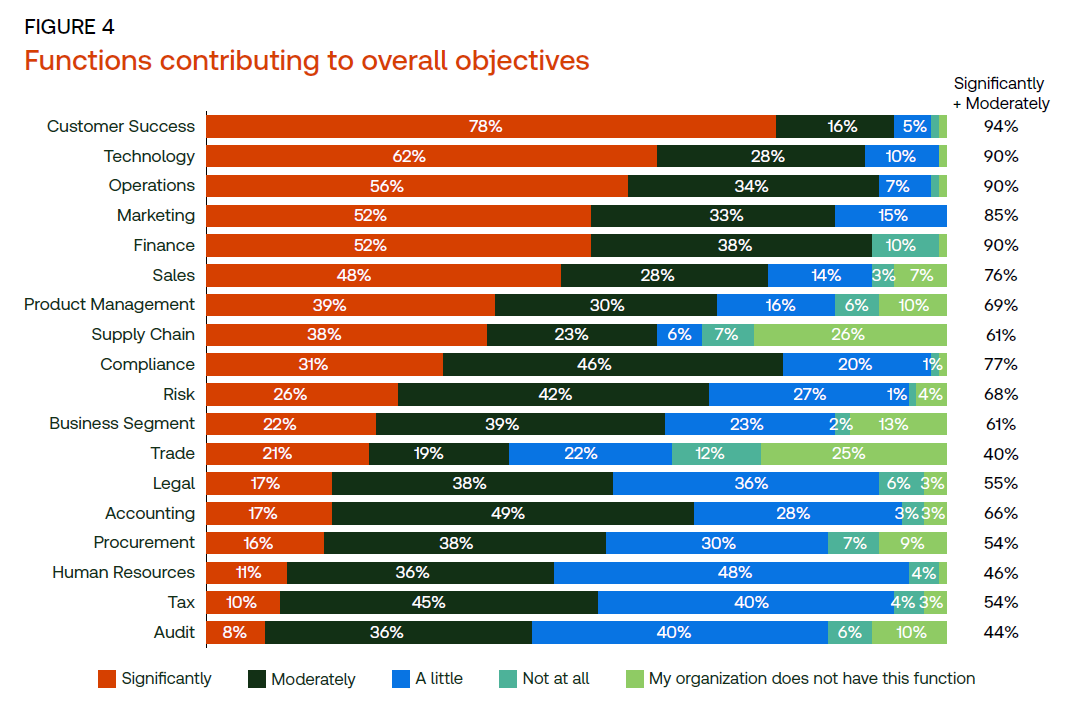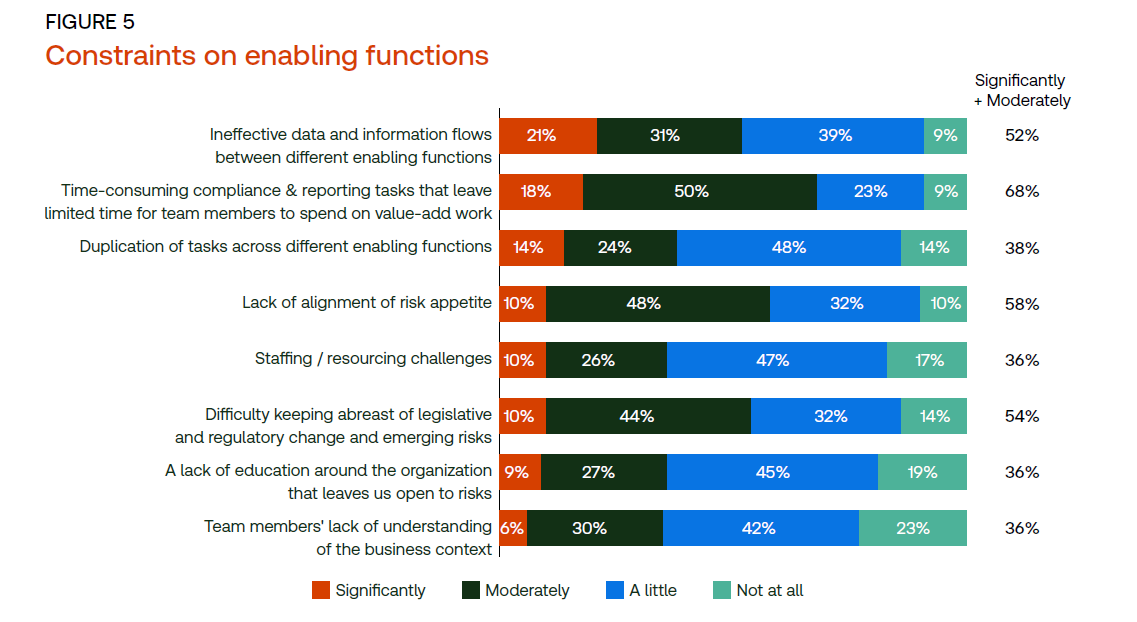New research shows C-Suite executives are redefining business success by prioritizing customer satisfaction and retention, and urging their legal, tax, and risk departments to align technology initiatives with customer-centric goals and not just internal efficiency
Key points:
-
-
-
C-Suite priorities — C-Suite leaders are prioritizing customer satisfaction and retention as key measures of business success.
-
Leveraging internal metrics — Most corporate function teams currently emphasize internal efficiency metrics over customer-centric outcomes when adopting new technologies like GenAI.
-
Aligning functions with company goals — C-Suites are calling on their legal, tax, and risk departments to align technology strategies with customer-focused goals, such as investment in improved data flows and integrated workflows.
-
-
At their core, the purpose of all corporate functions (sometimes called enabling functions) should be to provide the outcomes that their business leadership needs. Sometimes those are simple problems, and sometimes they can be bet-the-company disasters. However, for in-house legal, tax, and corporate risk & fraud departments alike, company success should be the primary goal.
That then begs the natural question: What does success actually mean? Companies want to make money, while not spending too much money, and they want to accomplish their legal and financial goals in the most efficient and cost-effective ways possible. And by and large, enabling functions have become attuned to those realities, increasingly leveraging technology to perform work quicker, cheaper, and with more overall efficiency.
In reality, however, the definition of success is more complicated. Clients want a strong bottom line, of course, but according to the recent 2025 C-Suite Survey from the Thomson Reuters Institute (TRI), there is another goal that’s top of mind among C-Suite leaders: customer satisfaction and retention. And unless legal, tax and corporate risk & fraud departments are aligning themselves to customer goals — and even more crucially, aligning their technology needs to customer goals — then they may not be achieving true success for their organization.
C-Suite definitions of success: Customer focus
It’s no surprise that C-Suites are focused on customers, of course; but there may be a misalignment between how much C-Suites want their business functions to focus on customers, and how much customer-focus those functions are actually doing. Past versions of the C-Suite Survey have found that while C-Suite leaders say they want their legal and tax departments to be more focused on customer-centric initiatives, legal and tax departments in actuality are more focused on risk mitigation tactics — even more so than their C-Suites desire.
This year’s version of the C-Suite Survey reveals similar priorities. While the financial bottom line remains paramount, most C-Suite leaders are also defining success directly via their customers. About two-thirds of C-Suite executives said they now include customer satisfaction in their definition of success, and more than half said they consider customer retention metrics.

Interestingly, this customer-centric focus does not only play out in conceptual definitions of success, or even primarily in the metrics surrounding success in the organization. Yet, this focus on customers directly impacts how C-Suites view their internal functions’ impact to the overall objectives of the company.
For example, when asked the extent to which certain functions contribute to the overall objectives of the company, in-house departments such as risk, legal, and tax all performed admirably, with more than half of C-Suite leaders saying they believe those departments to either significantly or moderately contribute to company objectives. Yet, the C-Suite still views some functions’ contributions with much more enthusiasm, with almost all (94%) of C-Suite respondents saying their customer success function — which often includes customer on-boarding, retention, marketing, and relationship management — significantly or moderately contributes to the overall objectives of the company.

Notably, however, it’s not just customers that catches the C-Suites’ attention. Ranking second is the technology function, which 90% of respondents say significantly or moderately contributes to overall company objectives. The fact that these two functions are seen as the top contributors (along with operations) is not an accident. Customer success and technology are increasingly intrinsically linked, with many C-Suite technology initiatives aimed directly at enhancing customer experience. As companies heavily invest in technology, they increasingly see their investment echoing what they believe customers want at the same time.
As legal, tax, and risk & fraud departments embark on their own technology journeys, it’s important for them to link technology initiatives to company objectives at large. And increasingly, that means not only thinking internally about technology use, but externally as well.
What it means for in-house departments of the future
When many professional services approach technology, particularly newer technologies such as generative AI (GenAI) and agentic AI, they often approach use cases that emphasize internal efficiency over any sort of external touchpoints.
For example, look at how these in-house departments defined success within TRI’s 2025 Generative AI in Professional Services Report. Just less than one-third of corporate respondents said their departments currently were measuring return on investment (ROI) of GenAI tools in the first place, meaning that many departments have no idea how GenAI initiatives are performing or even how that connects to the rest of the business. Further, among those respondents that said their departments were collecting ROI metrics, internal metrics (cost savings, employee usage, employee satisfaction) are far outpacing any external metrics (client satisfaction, external revenue generation, new business won) within most departments.
Of course, many enabling functions would argue that they’re inherently internal, and that they should not be expected to interface with customers. However, respondents to the C-Suite Survey would likely counter that if legal, tax, and risk departments want to contribute to company success, they should be more focused on customers — that’s how C-Suite leaders are defining business success overall, after all.
So, what does a customer-centric technology strategy look like for corporate functions? A look into how C-Suites believe these functions are constrained may shed some light.

C-Suite respondents identified a number of different constraints on enabling functions, ranging from compliance & regulatory issues to the alignment of risk appetite. With respect to technology, however, one stands out: A need for more effective data and information flows. In fact, a majority (52%) of C-Suite respondents said they believe ineffective data flows are significantly or moderately inhibiting enabling functions.
This is one example in which legal, tax, and risk functions can bolster not only internal efficiency, but align with customer-facing business needs as well. Bolstered data collection abilities and creating more integrated workflows allows for quicker and more accurate answers to customers, more complete financial information for reports and tax returns, and better overall decision-making around customer initiatives with more comprehensive data in mind.
There are other ways for enabling functions to be customer-centric with their technology as well, of course; but the overall goal is to be actively contributing to the C-Suite’s idea of success, and that means keeping customers top of mind when developing a technology strategy.
“It is clear that C-Suite leaders have established priorities for their businesses and measures for success. It is equally clear that many of the enabling functions could do a better job of working towards these broader corporate objectives,” the report states. “In digital transformation and AI, C-Suite leaders may have found the tools to mitigate or perhaps remove constraints from the organization’s enabling functions, ultimately helping those functions make more substantive contributions toward the organization’s overarching goals.”
You can download a copy of the Thomson Reuters Institute’s recent 2025 C-Suite Survey here







